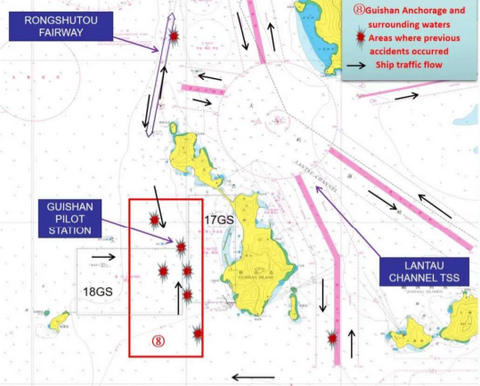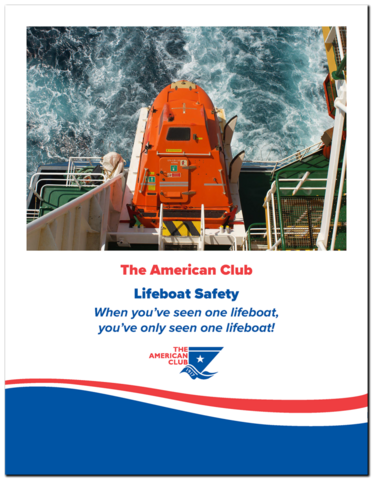
As the flood and typhoon season approaches in the PRC, currents and winds are expected to intensify at the Guishan anchorage and surrounding waters of the Pearl River Estuary. As shown in the diagram below, the area has recently seen an increased number of vessel collisions.

| Potential Hazards The Guishan anchorage and its surrounding waters are a convergence area for vessels navigating the Pearl River Estuary. Many vessels anchor at the 18GS anchorage area before entering port and many fishing vessels anchor at the 17GS anchorage resulting in limited vessel-handling maneuvering space in both areas. |
| The waters between the 18GS and 17GS anchorages are a customary route for inbound and outbound vessel traffic as well as a boarding and disembarking area for marine pilots. Vessels maneuver regularly in this heavy traffic area. The risks are compounded by possible miscommunications due to language barriers between vessels’ crews. Furthermore, vessel traffic flow is complicated by vessels often crossing the area. Vessels that anchor at the 18GS anchorage are generally larger and their deck lights may comingle with shoreside lights from Guishan Island possibly confusing vessels’ lookouts |
| Recommendations |
| 1.Vessels should avoid making large turns, accelerations and decelerations in the area. 2.Members are recommended to enhance the maintenance of vessels’ mechanical and electrical equipment and proceed at a safe speed as necessary. When anchoring, vessels should maintain additional lookouts as well as ensure engine readiness and preparedness in case of an emergency. 3.Vessels should ensure the display of appropriate navigational lights and shapes as regulations require and engage additional watch personnel on the bridge. Short range radar scanning and VHF communication should be employed to maintain contact with other vessels as necessary. 4.Vessels should maintain constant communication with the pilot station and be well prepared to embark and disembark pilots given the limited maneuverability to avoid collisions. 5.If the vessel is unable to make effective communications in the area, they should employ alternative means such as using the vessel’s whistle or seek assistance from the Guangzhou VTS via VHFF08/9 or via telephone at +86 12395. |
| The American Club’s correspondent, Oasis P&I Services, Ltd., are thanked most warmly for their assistance in this matter. |
___
LIFEBOAT SAFETY: WHEN YOU’VE SEEN ONE LIFEBOAT, YOU’VE ONLY SEEN ONE LIFEBOAT
Your Managers are pleased to announce the publication of a new guidance document, When You’ve Seen One Lifeboat, You’ve Only Seen One Lifeboat!
Mariners understand the critical necessity of lifeboats, but ideally hope never to use them. This may to some extent arise from a fear of unexpected malfunctions and accidents during lifeboat deployment, and may crate a reluctance among mariners to give the fullest attention to training in lifeboat use. This guidance highlights the importance of in-depth training, robust familiarity with the specific lifeboat onboard, and rigorous maintenance routines to ensure the safety and reliability of lifeboats.
Your Managers recommend that Members take note of this information and be guided accordingly






